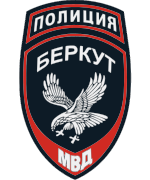
Back بيركوت Arabic Беркут (спецпадраздзяленне) Byelorussian Бэркут (спэцпадразьдзяленьне) BE-X-OLD Berkut Catalan Berkut (speciální jednotky) Czech Berkut (Spezialeinheit) German Berkut Esperanto Bérkut (Crimea) Spanish Berkut (Ukraina) Estonian یگان برکوت Persian
You can help expand this article with text translated from the corresponding article in Ukrainian. (January 2014) Click [show] for important translation instructions.
|
The Berkut (Ukrainian: Беркут; "golden eagle") was the Ukrainian system of special police (riot police) of the Ukrainian Militsiya within the Ministry of Internal Affairs.[4][5] The agency was formed in 1992, shortly after the dissolution of the Soviet Union, as the successor to the Ukrainian SSR's OMON.
Initially specialized in fighting organized crime, Berkut transitioned into a gendarmerie used by the Ukrainian Militsiya for public security, operating semi-autonomously at the local or regional level. The term "Berkut" came to be used for any professional special police unit in Ukraine. Prior to the 2014 Ukrainian revolution, the Berkut had a history of illegal activities against Ukrainian citizens, such as racketeering, terrorism, physical violence, torture, anti-Ukrainian sentiment, voter intimidation and other secret police tactics against those who would elect non-Yanukovych candidates. It committed violence against protesters during Euromaidan and the Orange Revolution.[6][7] After the revolution, the new government held the Berkut responsible for most of the Heavenly Hundred civilian deaths. Acting Ukrainian Interior Minister Arsen Avakov dissolved the agency on 25 February 2014, replacing it with the National Guard of Ukraine.[8][9]
In March 2014, Berkut units stationed in the Autonomous Republic of Crimea and Sevastopol defected to the Russian Ministry of Internal Affairs during the annexation of Crimea by Russia, after the territories were approved as federal subjects.[1][2][3][10][11]A There, the Berkut effectively became a Russian agency. Units were allowed to preserve their old name and now serve within the National Guard of Russia as the gendarmerie for Crimea.[3][10]
- ^ a b [1], Information Telegraph Agency of Russia (24 March 2014)
- ^ a b "сохранит свое название в составе органов МВД РФ". amicru. 25 March 2014. Retrieved 29 March 2014.
- ^ a b c Russian interior bodies created in Crimea and Sevastopol Archived 7 April 2014 at the Wayback Machine, ITAR-TASS (25 March 2014)
- ^ Berkut arrived to defend Yanukovych's Mezhihirya from journalists Archived 11 August 2014 at the Wayback Machine. ictv. 6 June 2013
- ^ Beaten up by Berkut neighbor of Yanukovych was recognized guilty and fined. 24tv. 18 January 2014
- ^ Cite error: The named reference
Business Insiderwas invoked but never defined (see the help page). - ^ Berkut Riot Police Used to Falsify Ukrainian Parliamentary Elections, The Jamestown Foundation (14 November 2012)
- ^ Ukraine's new rulers disband riot police Archived 24 September 2015 at the Wayback Machine, Reuters (26 February 2014)
- ^ Аваков распустил "Беркут" : Новости УНИАН 26 February 2014 | 01:10
- ^ a b Crimean Berkut police to preserve name as it incorporates into Russian Interior Ministry, ITAR-TASS (24 March 2014)
- ^ Ukraine: Speaker Oleksandr Turchynov named interim president, BBC News (23 February 2014)
Ukraine protests timeline, BBC News (23 February 2014)

